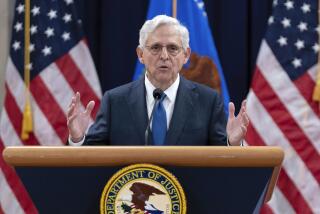Op-Ed: ‘Too big to fail’ equals ‘too eager to borrow’
- Share via
Four years ago this month, President Obama signed the Dodd-Frank Act into law, promising that the 848-page financial law would “put a stop to taxpayer bailouts once and for all,” he said. But recently, Massachusetts Sen. Elizabeth Warren told a Detroit crowd that “the biggest banks are even bigger than they were when they got too big to fail in 2008.”
Who’s right? Warren is, but ending “too big to fail” doesn’t just require Congress to make a better banking law. It has to do with us, and weaning Americans from their addiction to debt.
Despite wording in Dodd-Frank that was supposed to prohibit bailouts, large financial firms continue to benefit from investors’ perception that Washington would rescue them in another crisis. And they have reason to think this.
For the Dodd-Frank anniversary, House Republicans on the Financial Services Committee duly released a report reminding voters about what the law actually says.
The Republicans’ report notes that Dodd-Frank specifically authorizes the Federal Deposit Insurance Corporation to borrow from the federal government and in turn “lend [that money] to a failing firm,” whether to “purchase its assets; guarantee its obligations; and — most important — pay off its creditors.”
Under the formula Dodd-Frank set up — allowing the FDIC to borrow up to 90% of a failed firm’s assets — the FDIC could borrow $2.2 trillion to save JPMorgan Chase and $923 billion to bail out Goldman Sachs.
The law directs the FDIC to recoup that investment, if necessary, through assessing other large financial firms.
But in what other industry do a failed firm’s competitors have to bail it out? In a true free market, if one large bank makes such catastrophic errors that it goes bankrupt, other firms should benefit, taking on its customers and investors.
If you don’t trust the Republicans’ assessment, though — or Warren’s — listen to Timothy Geithner.
Geithner, Obama’s first-term Treasury secretary, helped create Dodd-Frank. But he told the New York Times magazine this spring that “of course” too-big-to-fail “still exist[s].” Ending it, he said, would be “not just quixotic, but misguided.”
Or, consider what’s on the agenda this fall for the G-20 summit of the 20 biggest economic powers. The Bank of England’s chief, Mark Carney, “is pushing for regulators to … ensure that the biggest cross-border institutions — such as HSBC, JPMorgan, and Deutsche Bank — would never need public money in a crisis,” the Financial Times reported Monday.
Ending “too big to fail” is not hard, technically speaking.
All Western governments must do is make it clear that in a crisis, the people and institutions who lent money to a large financial institutions will lose money — all of it, if necessary — right along with shareholders. The only people the government would — and should — protect are small depositors, regular folk with some cash in the bank.
When sophisticated lenders to large financial institutions know their money is at risk, they’ll lend more stingily, shrinking banks’ sizes.
OK, so why don’t we do that?
Because we don’t particularly want banks or their investors to pull back on their lending.
To understand why, you have to understand how we got “too big to fail” in the first place.
The tea party and Occupy Wall Street line is that evil banks corrupted greedy politicians, or vice versa. “It happens because they have lobbyists,” Warren told the crowd last week. Upstart Virginia congressional candidate David Brat toppled House Majority Leader Eric Cantor in a GOP primary last month thanks in part to Brat having linked Cantor’s pro-bailout vote in 2008 to the donations the congressman received from Wall Street.
But the real reason we have too-big-to-fail financial firms is because they provide Washington what it really wants: cheap debt for voters.
As veteran financier Daniel Alpert notes in his book “The Age of Oversupply,” since the 1980s, “the bottom 60% or so of households” — that’s a lot of people — have seen their wages either “stagnate” or “sharply decline” after inflation. Working-class people took the biggest hits.
What did the government — from Ronald Reagan through George W. Bush — do to make up the difference? “The public was showered with easy credit that allowed them to make up for lost income and maintain living standards — at least for a while,” Alpert notes.
Indeed, between 1980 and 2008, mortgage debt alone quadrupled after inflation (the population rose only 31%). Other consumer debt, auto loans and credit-card borrowing and the like, nearly tripled.
Who gave Americans the cheap credit? The big banks.
They would not have done so if their investors thought they’d be out of luck when reality bit.
And when reality did bite, Washington pushed it back. Federal Reserve intervention as well as President Obama’s decision to keep Fannie Mae and Freddie Mac have pushed mortgage rates down to record lows, buoying house prices.
It’s not just mortgages. Since 2009, the going interest rate for a four-year car loan has fallen from 6.7% to 4.5%. The average credit-card rate has fallen from 13.4% to 11.8%.
People are tempted. After falling since 2008 — back to 2004 levels — total debt has started to creep back up over the last year and a half. And everyone thinks that’s a good thing, as auto and retail sales, too, are up.
We don’t like our too-big-to-fail banks, but we like the easy money they provide.
Nicole Gelinas is a fellow at the Manhattan Institute and a contributing editor to City Journal. Twitter: @nicolegelinas
Follow the Opinion section on Twitter @latimesopinion
More to Read
A cure for the common opinion
Get thought-provoking perspectives with our weekly newsletter.
You may occasionally receive promotional content from the Los Angeles Times.










